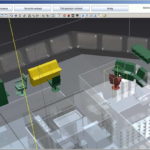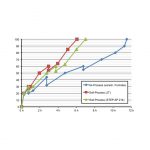A challenge in shipbuilding is the integration of a variety of trades, concurrent engineering and changes of the product during production on shop floor level. As-Built recording can improve production processes, planning and maintenance
Siemens PLM Software, a leading global provider of product lifecycle management (PLM) and manufacturing operations management (MOM) software, took part[ds_preview] in the state-funded German research project ARVIDA among 21 other partners. One of the sub-projects was to support shop floor workers with a tool that provides the backflow of information into the PLM system in an open, lightweight way. The developed demonstrator aims at the individual manufacturing industry, such as shipbuilding. One of the prerequisites was to enable partners to update their heterogeneous software systems with as-built shop floor information. Also, a benchmark of different ways to assess the possible methods was demanded.
Making use of the product model throughout the entire product lifecycle is a key to multiply the benefits from the efforts undertaken during product modelling. In individual manufacturing industries with a high complexity such as shipbuilding, special challenges apply: the integration of a variety of trades, concurrent engineering, late and numerous changes of the product during its production on shop floor level. Additionally, rising demands on the accuracy of the product model for construction-following processes such as production planning, materials planning, service, maintenance, repair, overhaul and use of the ship apply. These challenges form the need of an accurate as-built recording on shop floor level.
Together with a German shipyard, Siemens PLM Software took part in the German state-funded research project ARVIDA. The recording of the as-built was formulated as a subproject to meet the aforementioned challenges to achieve an updated product model (»digital twin«) for construction-following processes.
Open Approach
Taking the heterogeneous system landscape and huge product models of many shipyards and our research partner into account, it was decided to take an open approach. It is based on an open and lightweight strategy (OLS). This strategy was developed and outlined in a publication of the Chair for Virtual Product Development (VPE) in the Technical University of Kaiserslautern. All the construction-following processes and systems should benefit from an OLS-backbone as an open »pipeline« for the updated product model.In this case, as an OLS format, the JT file format was chosen – it is a well-established industry standard, also internationally standardized in ISO 14307. Traditionally used as a downstream format for various industry processes throughout the product lifecycle, here it was used as an upstream format. For the realizing software part, nearly all functions of the advanced viewing software Teamcenter Visualization could be accessed via the programming interface of PLM Vis Toolkit.
In the software demonstrator written for the research project, initial navigation is based on a section view of the ship, where a room, compartment or other predefined substructures can be selected. A corresponding product model is being loaded. Navigation and selection can be done via touch interface or mouse input. Single or multiple parts can be selected and assigned a status by clicking on of the four buttons in top row, which are »in progress«, »mounted«, »not mounted« or »changed«. Furthermore, a note can be attached. The user interface is being held as simple as possible in order to minimize training cost and ensure quick success in a first step. In a second step, extensions such as the integration of Product and Manufacturing Information (PMI) as well as the possibility to use isometric representations in 2D have been made. Speaking of Hardware, basically any Windows based system such as tablet, notebook and terminals can run the software. The software works offline, because providing network access is usually not possible or at least difficult inside the ship hull. Synchronisation can take place e.g. at the end of the work day.
A process valuation model was developed in order to measure the improvements of the approach, especially considering the different data formats and their adapted processes. The process valuation model is based upon the works of Niklas Hochstein and was extended by the author of this article. In this process valuation model, a basic assumption is set: Each product model has a degree of achievement, meaning how »complete« it is. This degree of achievement undergoes so-called design-drops and design rises. The extension of the process valuation model aims at measuring the effects of data formats. For this purpose, the support of requirements in each process steps are counted, weighted and put in to a number that shows the suitability of a data format in a process step. Additionally, the lack of support of certain requirements in a process step prior to a currently regarded process step leads to a lowering of this estimate. This estimate causes the drops in the degree of achievement (design drops). Drawing a diagram of the degree of achievement over time, design drops can easily be identified as well as the performance of data formats in the chain of processes.
The model showed clearly the advantage of an OLS format (JT) compared to a mixture of formats (see “versch. Formate” in the diagram) in the existing process as well as an advantage compared to a non-lightweight format (STEP AP 214). With the combination of requirements from the industry, a research project with an open approach and present PLM tools, an efficient approach for the recording of the as-built has been made.
Matthias Roth, Siemens Industry Software GmbH , matthias.roth@siemens.com






















